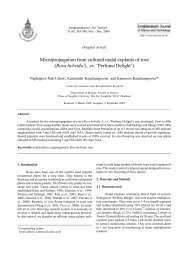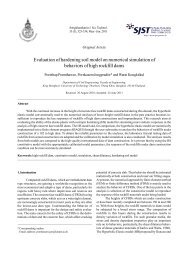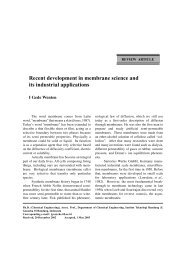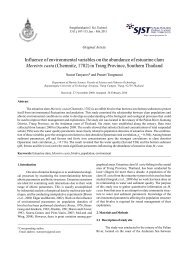lyase (PAL) activity in mangosteen
lyase (PAL) activity in mangosteen
lyase (PAL) activity in mangosteen
You also want an ePaper? Increase the reach of your titles
YUMPU automatically turns print PDFs into web optimized ePapers that Google loves.
Songklanakar<strong>in</strong> J. Sci. Technol.<br />
Vol.27 No.4 Jul. - Aug. 2005 712<br />
Bagg<strong>in</strong>g and storage temperature on anthocyan<strong>in</strong> content and <strong>PAL</strong><br />
Ratanamarno, S., et al.<br />
15º, 25º, 30º (room temperature) and 35ºC. It was found that temperature had no effect on anthocyan<strong>in</strong><br />
content <strong>in</strong> any stage of fruit development. At all temperature levels, the anthocyan<strong>in</strong> content was <strong>in</strong>creased<br />
accord<strong>in</strong>gly and had the highest level at stage 6. Temperature affected on <strong>PAL</strong> <strong>activity</strong> at different stages.<br />
Levels of <strong>PAL</strong> <strong>activity</strong> decreased at the early stages and <strong>in</strong>creased at the f<strong>in</strong>al stage of maturity except for<br />
fruits held at 25ºC, <strong>PAL</strong> <strong>activity</strong> rema<strong>in</strong>ed at a low level through stage 6, while fruit at 35ºC had the highest<br />
level of <strong>PAL</strong> at stage 5.<br />
Key words : <strong>mangosteen</strong>, anthocyan<strong>in</strong>, phenylalan<strong>in</strong>e ammonia-<strong>lyase</strong> (<strong>PAL</strong>)<br />
∫∑§—¥¬àÕ<br />
ÿ®‘µ√“ √µπ–¡‚π 1 ®”πߧå Õÿ∑—¬∫ÿµ√ 2 ·≈–°Õ∫‡°’¬√µ‘ · ßπ‘≈ 2<br />
º≈¢Õß°“√ÀàÕº≈·≈–Õÿ≥À¿Ÿ¡‘„π°“√‡°Á∫√—°…“µàÕª√‘¡“≥√ߧ«—µ∂ÿ·≈–°‘®°√√¡¢Õ߇Õπ‰´¡å<br />
øïπ‘≈Õ≈“π’π·Õ¡‚¡‡π’¬‰≈‡Õ „π‡ª≈◊Õ°º≈¡—ߧÿ¥√–À«à“ß°“√ ÿ°·°à<br />
«. ߢ≈“π§√‘π∑√å «∑∑. 2548 27(4) : 711-717<br />
°“√∑¥≈Õßπ’ È¡’«—µ∂ÿª√– ߧå‡æ◊ËÕ»÷°…“º≈¢Õß°“√ÀàÕº≈¡—ߧÿ¥·≈–Õÿ≥À¿Ÿ¡‘„π°“√‡°Á∫√—°…“∑’<br />
Ë¡’µàÕ°“√‡ª≈’ ˬπ<br />
·ª≈ߪ√‘¡“≥¢Õß·Õπ‚∑‰´¬“π‘π·≈–°‘®°√√¡¢Õ߇Õπ‰´¡åøïπ‘≈Õ≈“π’π ·Õ¡‚¡‡π’¬‰≈‡Õ (<strong>PAL</strong>) ¢Õ߇ª≈◊Õ°º≈<br />
¡—ߧÿ¥„π√–À«à“ß°“√æ—≤π“ ’¢≥–∑’ ˺≈¡’°“√ ÿ°·°à (√–¬–∑’ Ë 1 ∂÷ß√–¬–∑’ Ë 6 ¥Ÿ®“°°“√°√–®“¬¢Õß ’¡à«ß·¥ß∫π‡ª≈◊Õ°<br />
º≈) ‚¥¬∑”°“√ÀàÕº≈·≈–‰¡àÀàÕº≈∫πµâπ¥â«¬∂ÿß°√–¥“… æ∫«à“· ߉¡à¡’º≈µàÕ°“√‡ª≈’ ˬπ·ª≈ß°‘®°√√¡¢Õ߇Õπ‰´¡å<br />
<strong>PAL</strong> ·≈–ª√‘¡“≥·Õπ‚∑‰´¬“π‘π ‚¥¬°‘®°√√¡¢Õ߇Õπ‰´¡å·≈–ª√‘¡“≥·Õπ‚∑‰´¬“π‘π„πº≈∑’ËÀàÕ·≈–‰¡àÀàÕ‡¡◊ËÕ<br />
‡ª√’¬∫‡∑’¬∫°—π„π∑ÿ°√–¬–¡’§à“‰¡à·µ°µà“ß°—π∑“ß ∂‘µ‘ à«π°“√»÷°…“º≈¢ÕßÕÿ≥À¿Ÿ¡‘¢≥–‡°Á∫√—°…“π—Èπ∑”‚¥¬°“√<br />
‡°Á∫º≈¡—ߧÿ¥®“°µâπ„π√–¬–∑’ Ë 1 π”¡“‡°Á∫√—°…“‰«â∑’ ËÕÿ≥À¿Ÿ¡‘·µ°µà“ß°—π 4 √–¥—∫ §◊Õ 15, 25, 30 (Õÿ≥À¿Ÿ¡‘ÀâÕß)<br />
·≈– 35appleC ‡¡◊ËÕº≈¡—ߧÿ¥¡’°“√æ—≤π“¢Õß ’·¥ß‡æ‘Ë¡¢÷Èπ„π√–À«à“ß°“√ ÿ°·°à√–¬–µà“ßÊ ‰ª®π∂÷ß√–¬–∑’Ë 6 æ∫«à“<br />
Õÿ≥À¿Ÿ¡‘„π°“√‡°Á∫√—°…“‰¡à¡’º≈µàÕª√‘¡“≥·Õπ‚∑‰´¬“π‘π„π∑ÿ°√–¬– ∑— Èßπ’ È„π∑ÿ°√–¥—∫Õÿ≥À¿Ÿ¡‘ ª√‘¡“≥·Õπ‚∑-<br />
‰´¬“π‘π¡’·π«‚π⡇æ‘Ë¡¢÷Èπ„π∑‘»∑“߇¥’¬«°—π·≈–¡’ª√‘¡“≥ Ÿß ÿ¥„π√–¬–∑’Ë 6 ·µàÕÿ≥À¿Ÿ¡‘¡’º≈µàÕ°“√‡ª≈’ˬπ·ª≈ß<br />
°‘®°√√¡¢Õ߇Õπ‰´¡å <strong>PAL</strong> „π·µà≈–√–¬–¢Õß·µà≈–Õÿ≥À¿Ÿ¡‘∑’ˇ°Á∫√—°…“ ‚¥¬°‘®°√√¡¢Õ߇Õπ‰´¡å¡’·π«‚πâ¡≈¥≈ß<br />
„π√–¬–·√°Ê ·≈–‡æ‘Ë¡ Ÿß¢÷Èπ„π√–¬–À≈—ß ¬°‡«âπº≈∑’ˇ°Á∫∑’ËÕÿ≥À¿Ÿ¡‘ 25appleC °‘®°√√¡¢Õ߇Õπ‰´¡å¬—ß§ß¡’§à“µË”„π<br />
√–¬–∑’ Ë 6 ¢Õß°“√ ÿ°·°à¢Õߺ≈·≈–º≈∑’ ˇ°Á∫√—°…“∑’ ËÕÿ≥À¿Ÿ¡‘ 35appleC ¡’°‘®°√√¡¢Õ߇Õπ‰´¡å Ÿß ÿ¥∑’ Ë√–¬–∑’ Ë 5<br />
1 ¿“§«‘“‡∑§‚π‚≈¬’À≈—ß°“√‡°Á∫‡°’ ˬ« §≥–«‘»«°√√¡·≈–Õÿµ “À°√√¡‡°…µ√ ¡À“«‘∑¬“≈—¬·¡à‚®â Õ”‡¿Õ —π∑√“¬ ®—ßÀ«—¥‡’¬ß„À¡à<br />
50290 2 ¿“§«‘“’««‘∑¬“ §≥–«‘∑¬“»“ µ√å ¡À“«‘∑¬“≈—¬‡’¬ß„À¡à Õ”‡¿Õ‡¡◊Õß ®—ßÀ«—¥‡’¬ß„À¡à 50200<br />
Fruit colour, an important market<strong>in</strong>g<br />
attribute of <strong>mangosteen</strong> (Garc<strong>in</strong>ia mangostana L.),<br />
<strong>in</strong>fluences both consumer acceptance and sales.<br />
The attractive purplish-red of <strong>mangosteen</strong> is<br />
ma<strong>in</strong>ly anthocyan<strong>in</strong>. The major pigment is<br />
cyanid<strong>in</strong>-3-sophoroside, and the m<strong>in</strong>or pigment is<br />
cyanid<strong>in</strong>-3-glucoside (Du and Francis, 1977).<br />
Mangosteen is ready to harvest when pericarp is<br />
light greenish yellow scatter<strong>in</strong>g with p<strong>in</strong>kish spots,<br />
m<strong>in</strong>imum stage for harvest<strong>in</strong>g (Tongdee and<br />
Suwanagul, 1989). Total anthocyan<strong>in</strong> content<br />
<strong>in</strong>creased cont<strong>in</strong>uously dur<strong>in</strong>g maturation and<br />
reach<strong>in</strong>g a maximum value at fully ripe stage<br />
(Ratanamarno et al., 1999).<br />
Environmental and cultural factors <strong>in</strong>fluence<br />
fruit colour development. Temperature and light<br />
are two environmental factors that are important<br />
for red pigment development <strong>in</strong> fruit (Saure,<br />
1990). Anthocyan<strong>in</strong> synthesis <strong>in</strong> the apple fruit cv.<br />
Jonathan is light-dependent and may be further<br />
stimulated by several treatments <strong>in</strong>clud<strong>in</strong>g UV light<br />
(Chalmers and Faragher, 1977). Kliewer (1970)



![PDF [578 K]](https://img.yumpu.com/19892772/1/184x260/pdf-578-k.jpg?quality=85)
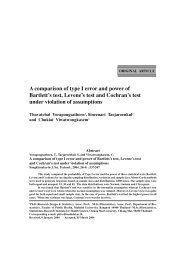
![PDF [835 K]](https://img.yumpu.com/16670486/1/184x260/pdf-835-k.jpg?quality=85)

![PDF [334 K]](https://img.yumpu.com/15675288/1/184x260/pdf-334-k.jpg?quality=85)
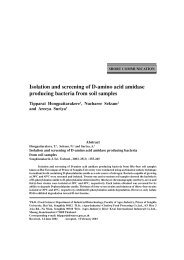
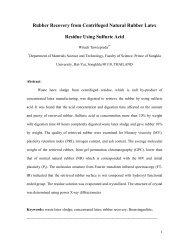
![PDF [925 K]](https://img.yumpu.com/13132196/1/184x260/pdf-925-k.jpg?quality=85)
